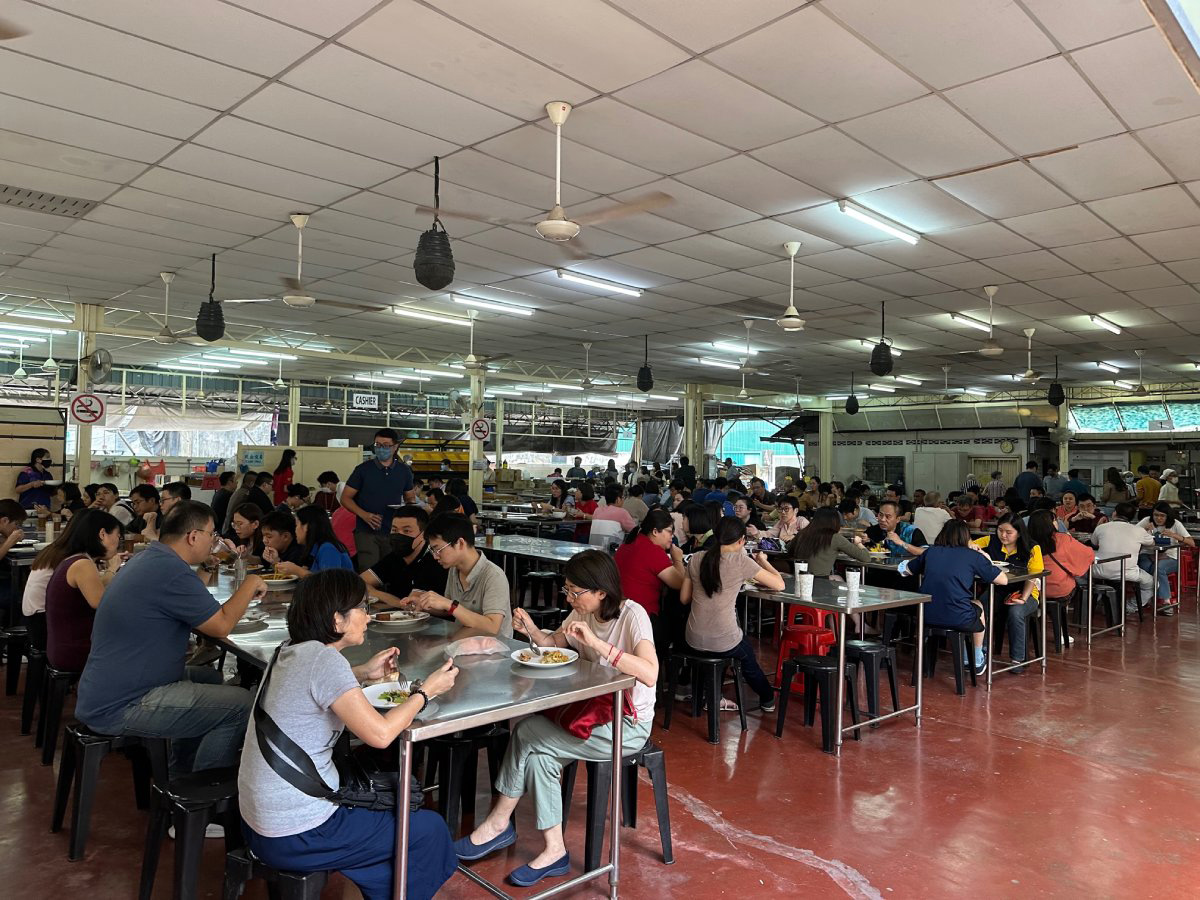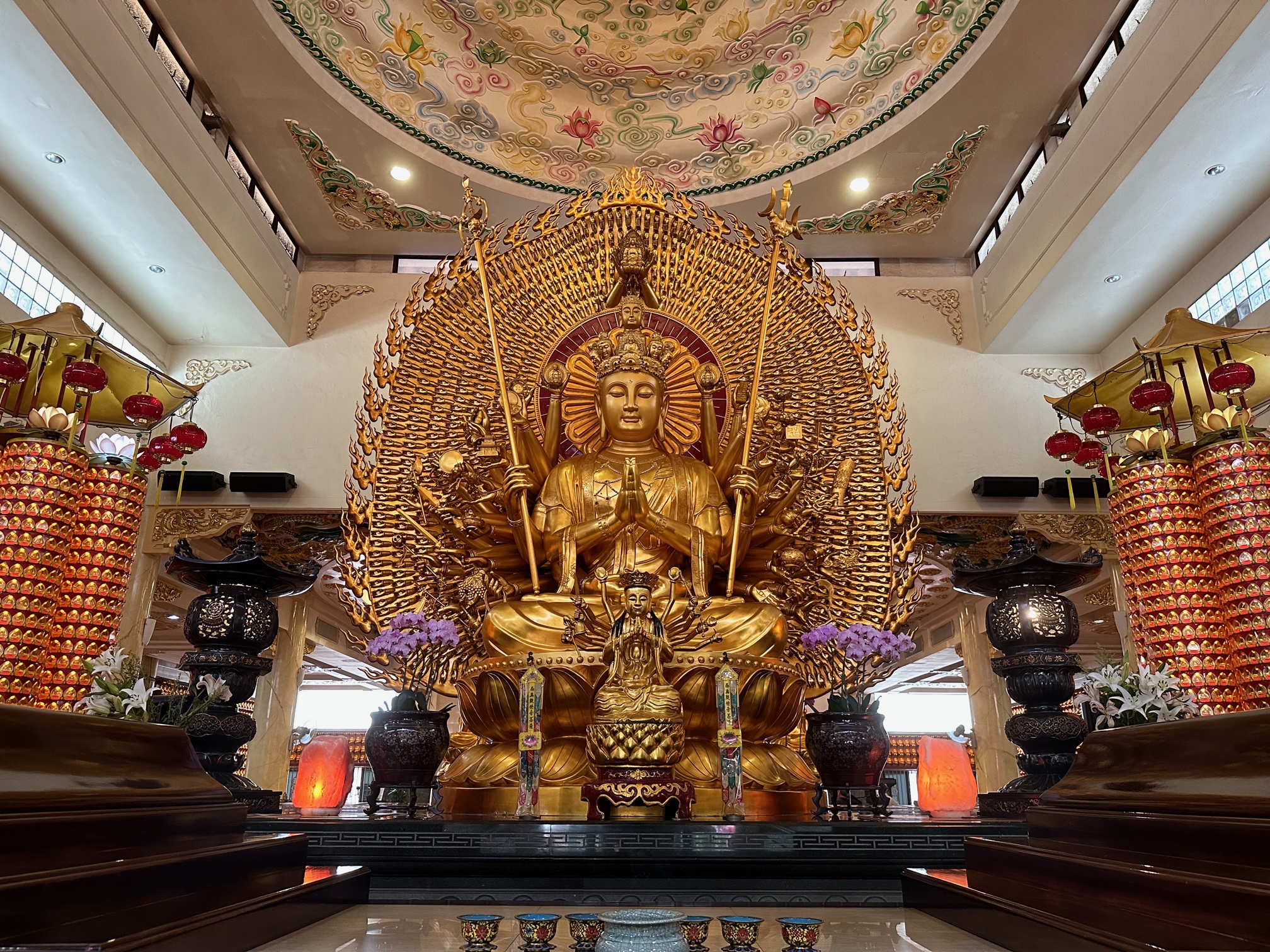With a history of one and a half centuries, Dharma Realm Guan Yin Sagely Monastery is one of Kuala Lumpur’s most striking landmarks, surrounded by high-rise construction, skyscrapers, and bustling roads. It is a restored temple under the stewardship of the Malaysia Dharma Realm Buddhist Association in Kuala Lumpur, which promotes the spiritual vision of Master Hsuan Hua (1918–95). The interior of the monastery has been restored, and the grandeur of the main hall and the Guan Yin statue are indisputable. Nevertheless, the greatest surprise to this non-Malaysian outsider lay behind the temple, in the form of what is modestly named a “vegetarian fast food center.”
It is much more than that. Called formally the Dharma Realm Guan Yin Sagely Monastery Food Centre, this is an outdoor but sheltered restaurant in the heart of the Malaysian capital, run entirely by volunteers, with an eye-wateringly diverse menu with delicious food on the cheap. Most importantly, it is open to every single person that turns up for lunch. There are plenty of tourists and hustling professionals that drop by, crossing the busy main road of Jalan Ampang or coming from either direction of the Four Seasons Hotel or the British High Commission, to enjoy a lunch among like-minded vegetarians, whether for the day or for life. And there are many like-minded.

Last Friday, I came back from spending lunchtime there with Lim Kooi Fong, editor of Buddhist Channel and a regular fixture among the old guard of lay Malaysian Buddhists. “Look at all the office workers coming here,” he noted as we sat down with our trays, and I diligently observed the many young men and women streaming in and out of the canteen. Many of them had office fobs dangling from their necks. But there were also those that had come to the temple to follow the sutra chanting or worshipping Guan Yin and the Buddha. In terms of size, the canteen outclasses anything I experienced in Hong Kong, including the famed Po Lin Monastery’s vaunted vegetarian set lunches for tourists. Then there is the food. It simply is not comparable: a buffet of over twenty vegetarian dishes, all waiting for patrons to pick at, cooked fresh and at a very high quality (at least from what I could tell of the dishes that I picked). Lim and I ended up at 20 ringgits for a plate for two people: the equivalent of 40 HKD.

This food hall would have seemed to be a prime example of a success story for Dharma Realm and the Buddhists as a whole. On the other hand, as Lim observed, it was impossible to tell at face value just how many of these patrons would end up seriously considering adopting Buddhism as a spiritual force in their daily lives (which is, if all Buddhist institutions are honest, their ultimate goal in reaching out). Yet among the big Buddhist organizations of Malaysia, there is no coherent approach or intellectual framework through which to approach the future of the Buddhist diffusion in the Malay Archipelago.
Like with many of Malaysia’s most successful Buddhist organizations, Dharma Realm is an imported institution, along with Tzu Chi, Fo Guang Shan, and a slew of other Mahayana and Vajrayana organizations. During our lunch, I consulted Lim on what were the distinct issues facing Malaysian Buddhism. While Buddhists found an early foothold in the early days of the Chinese tin miners and the clan houses that were eventually converted to temples, the organic political configuration of Malaya reflected the eclectic, disorganized way in which Buddhists had to organize without state support. This organic eclecticism, driven more by outward forces like influential and large Buddhist organizations like Tzu Chi, Fo Guang Shan, and indeed Dharma Realm, mirrors the way immigration has played in interacting with Malays and indigenous groups historically.

The religious landscape had inevitably political origins. “Malaysia’s religious world is split between the Muslim and non-Muslim,” said Lim. “A soft form of segregation organically developed, not just during colonialism but afterward as our post-independence governments increasingly leaned on the Malay Muslim bloc with successive administrations.” As a long-time resident of Kuala Lumpur and a proud Malaysian that enjoys not only his country’s history but keeps track of his clan house’s roots (something that even Chinese in China might not be so diligent at), he admits that this system is far from perfect. “We Chinese form the majority Buddhist population. As long as we do not step on the toes of the Muslims, or try to mess with the Islamic nature of the government, we have been given the freedom to do whatever we want.”
And that is true from both the human resources and the legal levels, from buying large plots of land (unimaginable to Buddhist danapati in Hong Kong) for building temples to mobilizing huge numbers of youth and devotees for Dharma events. While the informal segregation is undoubtedly a waste (consider the potential Sino-Malay friendships lost throughout childhood or the denied opportunities at dialogue on contentious and sensitive political issues), there is no doubt that Buddhists are left alone. “We Chinese are all, literally, immigrants. We have kept traditions better than even some on the mainland or in Hong Kong because this is all we have,” said Lim.

In this strange way, it actually works, especially in light of how ethnic tensions played out in the 1998 Indonesia riots (1,200 Chinese people were killed and nearly 200 women raped) and the mass killings targeting Chinese from 1965–1966. Separation from Malays was unpalatable, but in practical terms led to peace and, eventually mutual tolerance for each other’s ways.
But whether this freedom indicates a state of thriving or merely an equilibrium that can ensure survival, is an open question. Lim argues that Buddhists as a whole are not particularly thriving.
As I watch the multi-ethnic, vibrant, and demographically young mass of diners enjoying their food at the Dharma Realm Guan Yin Sagely Monastery Food Centre, I can sense Lim’s feeling, this instinct, about Malaysian Buddhism: rich and full of potential, with already significant resources and successes, yet still missing something.


